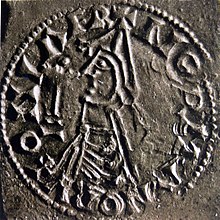St. Olof
| Olaf II | |||||||||
|---|---|---|---|---|---|---|---|---|---|

Coin of Olaf dated 1023–28.
|
|||||||||
| King of Norway | |||||||||
| Reign | 1015 – 1028 | ||||||||
| Predecessor | Sweyn Forkbeard | ||||||||
| Successor | Cnut the Great | ||||||||
| Born | 995 Ringerike, Norway |
||||||||
| Died | 29 July 1030 (aged 34–35) Stiklestad, Norway |
||||||||
| Spouse | Astrid Olofsdotter | ||||||||
| Issue |
Wulfhild, Duchess of Saxony Magnus, King of Norway (illegitimate) |
||||||||
|
|||||||||
| House | St. Olaf | ||||||||
| Father | Harald Grenske | ||||||||
| Mother | Åsta Gudbrandsdatter | ||||||||
| Religion | Chalcedonian Christianity | ||||||||
| Full name | |
|---|---|
| Olaf Haraldsson | |
| Regnal name | |
| Ólafr digri |
Olaf II Haraldsson (995 – 29 July 1030), later known as St. Olaf (and traditionally as St. Olave), was King of Norway from 1015 to 1028. He was posthumously given the title Rex Perpetuus Norvegiae (English: Eternal/Perpetual King of Norway) and canonised at Nidaros in (Trondheim) by Bishop Grimkell, one year after his death in the Battle of Stiklestad on 29 July 1030. His remains were enshrined in Nidaros Cathedral, built over his burial site. His sainthood encouraged the widespread adoption of the Christian religion.
Olaf's local canonisation was in 1164 confirmed by Pope Alexander III, making him a universally recognised saint of the Roman Catholic Church, and a commemorated historical figure among some members of the Lutheran and Anglican Communions. He is also a canonised saint of the Eastern Orthodox Church (feast day celebrated July 29th) and one of the last famous Western saints before the Great Schism.
The saga of Olav Haraldsson and the legend of Olaf the Saint became central to a national identity. Especially during the period of Romantic Nationalism, Olaf was a symbol of Norwegian independence and pride. Saint Olaf is symbolised by the axe in Norway's coat of arms and Olsok (29 July) is still his day of celebration. Many Christian institutions with Scandinavian links as well as Norway's Order of St. Olav are named after him.
Olaf II's Old Norse name is Ólafr Haraldsson. During his lifetime he was known as Olaf 'the fat' or 'the stout' or simply as Olaf 'the big' (Ólafr digri; Modern Norwegian Olaf digre). In Norway today, he is commonly referred to as Olav den hellige (Bokmål; Olaf the Holy) or Heilage-Olav (Nynorsk; the Holy Olaf) in honour of his sainthood.
...
Wikipedia
